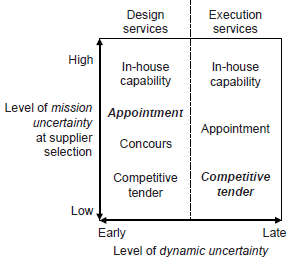Forming the Project Coalition
| Line 21: | Line 21: | ||
• The phase in the project life cycle – defines the level of the dynamic uncertainty. It increases with the time propagation in the project schedule. | • The phase in the project life cycle – defines the level of the dynamic uncertainty. It increases with the time propagation in the project schedule. | ||
| + | |||
| + | == Processes of procuring construction services == | ||
| + | |||
| + | A client have four ways to find most compatible supplier. Each method of procure is more convenient for different kids of the project stages: design, construction erection, resources/materials supply, quality surveys, estate maintenance. Selection is also related to the size of the project, uncertainties, phase in the project life cycle. These procure processes are: | ||
| + | |||
| + | • In-house capability: | ||
| + | |||
| + | A client is conducting an activity or operation within a company, instead of relying on outsourcing. A firm uses its own resources to perform the necessary tasks. | ||
| + | |||
| + | Advantages of in-house capability: | ||
| + | |||
| + | • Adjustable relation between client and supplier and no need of complete contract. | ||
| + | |||
| + | • Client has direct contact with a supplier and has full control on audit and evaluation of works. | ||
| + | |||
| + | • Aa | ||
| + | |||
| + | Disadvantages: | ||
| + | |||
| + | • Production inefficiency and rising production costs due to lack of competition. | ||
| + | |||
| + | • Low quality of the project maintains if construction is not the main business of the client. | ||
| + | |||
| + | • aa | ||
Revision as of 08:08, 12 June 2017
Contents |
Project Coalition
A coalition is defined as interaction of two o more members who adopt common strategy toward a common goal. The client’s task is to find the firms which will provide resources required and adopt most convenient cooperation-model to fulfil project mission. The process of procurement is used in the construction industry for selection and review of different suppliers and services. And the resource base is analysed based on the criteria such as price, value and reputation.
Client and suppliers
The client deals with the problem of asymmetry of information once, and what occurs most often, the suppliers knows more about its real competence in supplying required resources. The client needs a tools to investigate the supplier quality, reliability and price for resources. In the field of construction the asymmetry generates two problems defines as: Moral hazard and Adverse selection. Both are related to reliability of a supplier.
• Moral hazard – How can the client be sure that the firm will fully mobilise its capabilities on the client’s behalf.
• Adverse selection – How the client be sure that the most enthusiastic offer of the requested resources is not also the most desperate.
Selection of appropriate procurement
Selection of the supplier depends on the level of the uncertainty and the resources required in the time of making decision. According to the Graham M. Winch selection method can be illustrated as function of level of dynamic uncertainty and level of mission uncertainty, see figure 1.From the graph we can establish the most appropriate method of the procuring services for our project and stage in which it is. For example the client is planning to build simple multifamily building with repetitive structure and is at the early stage of the schedule. The level of mission uncertainty is low and dynamic uncertainty is at the early stage so most appropriate is the use of competitive tendering. The decision making is based on the two interacting dimensions defined as:
• The level of mission uncertainty – the uncertainty is increasing for the big and unique projects
• The phase in the project life cycle – defines the level of the dynamic uncertainty. It increases with the time propagation in the project schedule.
Processes of procuring construction services
A client have four ways to find most compatible supplier. Each method of procure is more convenient for different kids of the project stages: design, construction erection, resources/materials supply, quality surveys, estate maintenance. Selection is also related to the size of the project, uncertainties, phase in the project life cycle. These procure processes are:
• In-house capability:
A client is conducting an activity or operation within a company, instead of relying on outsourcing. A firm uses its own resources to perform the necessary tasks.
Advantages of in-house capability:
• Adjustable relation between client and supplier and no need of complete contract.
• Client has direct contact with a supplier and has full control on audit and evaluation of works.
• Aa
Disadvantages:
• Production inefficiency and rising production costs due to lack of competition.
• Low quality of the project maintains if construction is not the main business of the client.
• aa
